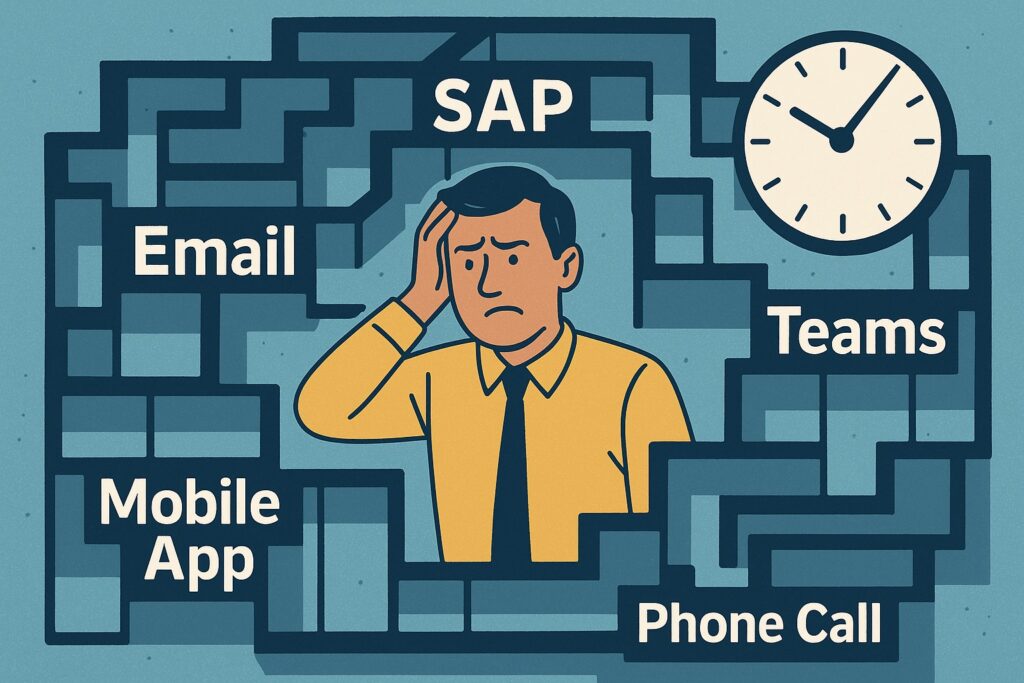The £1.6M Hidden Tax: How Context Switching is Bankrupting Your SAP Investment
The £1.6M Hidden Tax: How Context Switching is Bankrupting Your SAP Investment
Every year, your organization pays a hidden tax that doesn't appear on any financial statement, yet often exceeds your SAP maintenance costs. This tax isn't imposed by governments or vendors—it's self-inflicted through fragmented workflows that systematically erode the productivity gains your SAP investment was designed to deliver.
For a typical 100-user SAP organization, this hidden tax costs £1.6 million annually in lost productivity. That's £4,398 every single day—a relentless drain on operational efficiency that compounds with every delayed decision, every frustrated employee, and every missed business opportunity.

The Productivity Paradox
Organizations invest millions in SAP to integrate business processes, eliminate silos, and create operational efficiency. Yet most implementations fragment those carefully integrated processes across disconnected communication channels, recreating the very inefficiencies SAP was designed to solve.
Consider the stark mathematics: SAP implementations typically cost £250,000 to over £10 million for licensing and implementation services. Industry research consistently shows that 40-60% of implementations exceed original budget estimates. Organizations justify these massive investments based on promised productivity improvements and operational efficiency gains.
Then they route approvals through email chains that take 18.6 hours average completion time, forcing users to switch between multiple applications dozens of times daily, and recreating the manual coordination challenges that SAP was specifically designed to eliminate.
It's equivalent to installing a high-performance engine in a Ferrari, then forcing it to stop every few minutes to change gears manually. The technological capability exists, but the operational implementation cripples performance.
Quantifying the Hidden Costs
Unlike direct expenses such as software licenses or hardware purchases, context switching costs remain largely invisible. They manifest as delayed decisions, extended project timelines, increased error rates, and missed business opportunities—all of which impact the bottom line but rarely get attributed to their root cause.
The Base Calculation Framework
Research from multiple universities provides the foundation for calculating context switching costs:
- Time Loss per Switch: University of California, Irvine research documents 25 minutes and 26 seconds average recovery time after application interruptions.
- Daily Switch Frequency: Workplace analytics studies show SAP users average 10.2 application switches daily due to email-based workflow notifications and disconnected communication channels.
- Compensation Costs: Total compensation including salary, benefits, and organizational overhead typically ranges from £35-150 per hour for knowledge workers.
- Working Days: Standard 230 working days annually accounting for holidays and vacation time.
Conservative Cost Analysis
Using moderate assumptions for a 100-user SAP organization:
- Daily Productivity Loss: 10.2 switches × 25.4 minutes recovery × £50 hourly cost = £215 per user daily
- Annual User Impact: £215 daily × 230 working days = £49,450 per user annually
- Organizational Total: £49,450 × 100 users = £4.945 million annual productivity loss
- Conservative Adjustment: Applying 30% realization factor for realistic implementation = £1.484 million annual loss
Even with conservative assumptions that account for variation in task complexity and recovery time, the annual productivity loss approaches £1.6 million for a mid-sized SAP organization.
Hidden Cost Categories
The base time-loss calculation represents only the most measurable component of context switching costs. Additional cost categories compound the financial impact:
- Decision Quality Degradation: Research from behavioural economics studies shows that cognitive overload from frequent task switching leads to suboptimal decision making. When managers rush through approval processes due to attention fragmentation, they may approve requests warranting deeper scrutiny or reject valuable initiatives due to incomplete analysis.
- Error Rate Increases: Context switching directly correlates with increased error rates across multiple research studies. When users frequently switch between SAP screens and other applications, they're more likely to enter incorrect values, post to wrong accounts, or skip critical validation steps.
- Employee Satisfaction Impact: The psychological toll of constant context switching extends beyond immediate productivity metrics. Research shows that employees report significantly higher stress levels when working in fragmented environments, leading to increased sick days, reduced engagement, and higher turnover risk.
- Competitive Disadvantage Accumulation: While your organization routes approvals through email chains, competitors with integrated workflows make decisions in real-time. This speed disadvantage compounds with every delayed supplier negotiation, missed market opportunity, and slow customer response.
The SAP Investment Protection Crisis
The context switching cost calculations become particularly concerning when viewed against the massive investments organizations make in SAP implementations:
Implementation Cost Reality
SAP implementations represent some of the largest technology investments most organizations ever make. Beyond initial licensing and implementation services, organizations invest heavily in:
- Customization and Configuration: Industry-specific requirements and organizational workflow adaptations
- Training and Change Management: Comprehensive user education and adoption programs
- Integration and Data Migration: Connecting SAP with existing systems and transferring historical data
- Ongoing Maintenance and Enhancement: Continuous system updates, optimizations, and capability additions
These investments are justified based on promised returns: integrated business processes, real-time operational visibility, improved decision-making speed, and enhanced competitive positioning through operational excellence.
ROI Erosion Through Poor Integration
When organizations accept fragmented workflows, they systematically erode their SAP return on investment:
- Process Fragmentation: Email-based workflows reintroduce the information silos and coordination challenges that SAP systems were designed to eliminate.
- Data Utilization Gaps: When business decisions happen through email discussions and informal communications, organizations lose the process insights and optimization opportunities that justify SAP analytics investments.
- User Adoption Challenges: Complex, fragmented workflows reduce user satisfaction and adoption rates, limiting the business value realization from SAP capability investments.
- Productivity Contradiction: Organizations may spend more on productivity losses than they invested in productivity improvement technology.
The Compounding Effect
Context switching costs don't remain static—they compound over time as organizations scale, processes become more complex, and competitive pressures increase:
Organizational Growth Impact
As organizations add SAP users, the productivity losses scale exponentially:
- 200-User Organization: £3.2 million annual productivity loss
- 500-User Organization: £8.0 million annual productivity loss
- 1000-User Organization: £16.0 million annual productivity loss
Process Complexity Multiplication
Enterprise organizations often run multiple SAP modules with interdependent workflows that amplify context switching challenges:
- Financial Management: Month-end close procedures involving multiple stakeholders and approval chains
- Procurement Operations: Purchase order workflows spanning suppliers, approvers, and budget managers
- Human Resources: Employee lifecycle processes involving managers, HR teams, and compliance requirements
- Project Management: Resource allocation and approval processes affecting multiple departments
Each additional process dimension creates new context switching opportunities and coordination challenges.
Competitive Velocity Pressure
Modern business environments demand increasingly rapid decision-making and response times. Organizations with fragmented workflows face growing disadvantage as:
- Customer Expectations: Clients expect immediate responses and rapid project execution
- Supplier Relationships: Vendors prioritize partners who can make quick decisions and process approvals efficiently
- Market Opportunities: Time-sensitive business opportunities go to competitors with streamlined internal processes
- Innovation Speed: Product development and strategic initiatives require rapid resource allocation and cross-functional coordination
The Strategic Solution Framework
Addressing the hidden tax of context switching requires strategic integration that brings SAP workflows into the collaboration environments where modern work actually happens. This isn't about training users to work more efficiently within fragmented systems—it's about eliminating fragmentation entirely.
Microsoft Teams Integration Advantage
Teams integration represents the optimal solution because:
- Existing Deployment: Teams is already deployed, security-approved, and adopted in most enterprise organizations
- Collaboration Hub: Teams has become the central nervous system where modern work coordination happens
- Mobile Optimization: Native mobile functionality enables anywhere, anytime business decisions
- Platform Ecosystem: Integration with Office 365, SharePoint, and Power Platform creates comprehensive workflow capabilities
Proven Implementation Approach
Platforms like Looply enable rapid Teams integration without the complexity and risk of custom development:
- Pre-Built SAP Connectivity: Proven integration components for major SAP environments
- Enterprise Security: Comprehensive compliance and audit capabilities
- Rapid Deployment: 6-9 week implementation timelines using established methodologies
- Risk Mitigation: Tested approaches that minimize business disruption during transition
The Strategic Imperative
The hidden tax of context switching isn't just an operational efficiency issue—it's a strategic business challenge that affects competitive positioning, employee satisfaction, and organizational agility. When productivity losses exceed implementation costs, when employee frustration drives talent retention challenges, and when competitive disadvantages compound daily, the cost of inaction becomes unsustainable.
Organizations face a strategic choice: continue paying the hidden tax of fragmented workflows, or invest in proven integration solutions that transform productivity losses into competitive advantages.
The mathematics are clear, the technology solutions exist, and the competitive advantages are measurable. The question isn't whether your organization can afford Teams-SAP integration—it's whether you can afford not to implement it.
Ready to calculate your organization's hidden tax and explore elimination strategies?
Download the Complete Financial Analysis: "The Hidden Productivity Crisis in SAP Organizations"
This comprehensive white paper provides detailed cost calculation frameworks, ROI analysis templates, and implementation roadmaps for transforming SAP productivity investments. Join executives and IT leaders who have used this research to build compelling business cases for workflow optimization and competitive advantage development.



